By REDintern Firdaus Khan. Photos by Lai Jun Wei/Red Sports, Koh Yizhe/Red Sports and reader Ben Goh.

Nick Dance (Singapore, #3) breaks free and charges forth. (Photo 1 © Lai Jun Wei/Red Sports)
Yio Chu Kang Stadium, Saturday, May 23, 2009 – Singapore put up a strong fight in the final game of their 2009 HSBC Asian 5 Nations campaign before falling 15-45 to Japan.
The final score, however, was not indicative of the amount of heart and soul that the Singapore team played with, as the men were determined to keep their opponents at bay and not go down without a fight.
Having already been crowned champions last week, Japan rested some key players for the fixture but they still showed enough quality to see off the challenge of Singapore.
It was a game with only pride on the line as the result would not change the final positions on the table with Singapore finishing last in the five-team group.
Singapore, who were keen to impress in front of their home fans, were undone in just eight minutes by the champions.
The Japanese took full advantage of the crack in the Singapore front line and broke through the middle before Hitoshi Ono easily scored a try to notch their first points for the evening.
It went from bad to worse for Singapore as the Japanese continued their onslaught, making the score 26-0 with only half an hour gone.
Japan proved their worth as they possessed a higher level and standard of playing which was apparent with their quick and often direction-changing passes and industrious move.
One of the highlights of the game was a low kick played down the right channel to allow Japan’s Ayumu Goromaru to run in for a try.
Singapore fly-half Ryan Cumbers converted a penalty, giving the home fans something to cheer about just before the break.
After the restart, the home side built on that after the restart as Cumbers converted another penalty to lift the home fans off their seats as they wondered if Singapore could continue to narrow the gap.
Unfortunately, their hopes were dashed almost immediately as Singapore were caught napping as Japan scored another try just moments later. Japan then took their foot off the pedal but they were still able to dictate and dominate play.
Cumbers was arguably Singapore's best player as he converted three more penalties and was never afraid to jump in to thwart the Japanese attacks.
Inevitably though, Japan still managed to find ways to score two more tries and never looked in trouble despite having a player sent to the sin bin midway through the second half.
The champions held on to win 45-15 to ensure a 100% win record in the 5 Nations while the defeat meant Singapore finished win-less and will participate in next year's Division 1 tournament.

Despite being tackled by a hoard of Singapore players, Masakazu Toyota (Japan, #19) edges near the try line… (Photo 2 © Lai Jun Wei/Red Sports)

… going down with players in tow… (Photo 3 © Lai Jun Wei/Red Sports)

… to hit the ground… (Photo 4 © Lai Jun Wei/Red Sports)

… for a try. (Photo 5 © Lai Jun Wei/Red Sports)

Ryan Cumbers (Singapore, #10) converts a place kick… (Photo 6 © Lai Jun Wei/Red Sports)
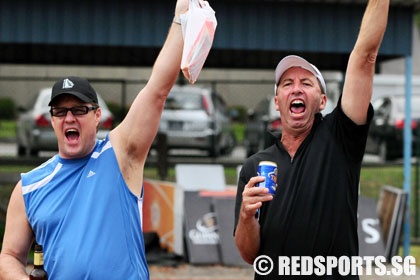
… much to the cheers of the Singapore supporters. (Photo 7 © Lai Jun Wei/Red Sports)

Takashi Kikitani (Japan, #6) passes to a team mate. (Photo 8 © Lai Jun Wei/Red Sports)

Chris Gilbert grabs the ball at the line-out. (Photo 9 © Lai Jun Wei/Red Sports)

Andrew Lee (Singapore, #9) clears a ball. (Photo 10 © Lai Jun Wei/Red Sports)

Head to head… (Photo 11 © Lai Jun Wei/Red Sports)

Ryan Cumbers runs through. (Photo 12 © Lai Jun Wei/Red Sports)

Singapore captain Ben Wheeler trying to break away from Tatsuhiko Otao (Japan, #10). (Photo 13 © Lai Jun Wei/Red Sports)

Japan lets the ball slip… (Photo 14 © Lai Jun Wei/Red Sports)

… for Alex Chew (Singapore, #14) to contest… (Photo 15 © Lai Jun Wei/Red Sports)

… only to be brought down soon after. (Photo 16 © Lai Jun Wei/Red Sports)

Steve Horsfall tries to avoid his opponent. (Photo 17 © Lai Jun Wei/Red Sports)

Ryan Cumbers tries to stop his opponent. (Photo 18 © Lai Jun Wei/Red Sports)

Andrew Lee passes to a team mate. (Photo 19 © Lai Jun Wei/Red Sports)

Some fumbling by Japan saw Singapore able to contest for the ball. (Photo 20 © Lai Jun Wei/Red Sports)

Alex Chew tries to stop his opponent from scoring a try. (Photo 21 © Lai Jun Wei/Red Sports)

Ben Wheeler tries to avoid his opponent. (Photo 22 © Lai Jun Wei/Red Sports)

Takashi Kikutani passes the ball. (Photo 23 © Lai Jun Wei/Red Sports)

A Japanese player runs with the ball. (Photo 24 © Lai Jun Wei/Red Sports)

Japan scores a try through Hitoshi Ono. (Photo 25 © Lai Jun Wei/Red Sports)
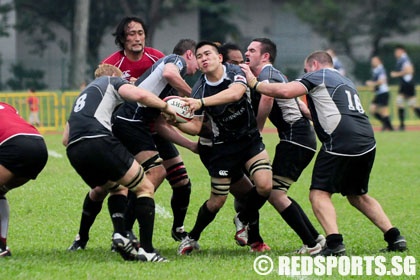
Jonathan Lee releases the ball to a team mate as he is tackled. (Photo 26 © Lai Jun Wei/Red Sports)

Holding the ball firm to the ground… (Photo 27 © Lai Jun Wei/Red Sports)

… and releasing it as his opponents pile on top of him. (Photo 28 © Lai Jun Wei/Red Sports)

Ben Wheeler at the line out. (Photo 29 © Lai Jun Wei/Red Sports)

A “Yio Chu Kang” wave went around the stadium. (Photo 30 © Lai Jun Wei/Red Sports)

A spectator’s child engrossed with his popcorn before the game. (Photo 31 © Lai Jun Wei/Red Sports)
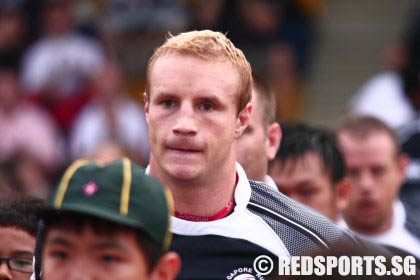
The face of concentration as Singapore captain Ben Wheeler leads his team out. (Photo 32 © Koh Yizhe/Red Sports)

A Singapore player drags a group of players along with him as he attempts to get out of a tough defensive situation. (Photo 33 © Koh Yizhe/Red Sports)

Hitoshi Ono avoids a Singapore challenge… (Photo 34 © Koh Yizhe/Red Sports)

… to score the first try of the evening. (Photo 35 © Koh Yizhe/Red Sports)

Alex Chew gets ready to receive the ball as his teammate is brought down by two Japanese players. (Photo 36 © Koh Yizhe/Red Sports)

A Japanese player shrugs off a Singapore player’s tackle. (Photo 37 © Koh Yizhe/Red Sports)

A Japanese player brings the ball forward. (Photo 38 © Koh Yizhe/Red Sports)

James Valintine (left) looks to help his teammate take down a Japanese player. (Photo 39 © Koh Yizhe/Red Sports)

Andrew Lee passes the ball out. (Photo 40 © Koh Yizhe/Red Sports)

Skipper Takashi Kikutani runs unchallenged as he makes his team’s second try of the evening. He scored a brace of tries in the match. (Photo 41 © Koh Yizhe/Red Sports)
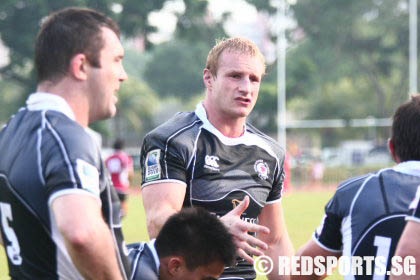
“I want the ball dead!” Ben Wheeler giving instructions to his players after Japan’s second try. (Photo 42 © Koh Yizhe/Red Sports)

A Japanese player attempts to convert. (Photo 43 © Koh Yizhe/Red Sports)

Gaspar Tan tries to prevent a Japanese player from kicking the ball forward. (Photo 44 © Koh Yizhe/Red Sports)

Singapore skipper Ben Wheeler gets the ball. (Photo 45 © Koh Yizhe/Red Sports)

A Japanese player pulls Ben Wheeler’s shirt as he attempts to get away. (Photo 46 © Koh Yizhe/Red Sports)

A Singapore player just misses his tackle, letting a Japanese player break free. (Photo 47 © Koh Yizhe/Red Sports)

Alex Chew gets taken down near his own try line. (Photo 48 © Koh Yizhe/Red Sports)

Eyeing the ball as players pile above him. (Photo 49 © Koh Yizhe/Red Sports)

Alex Chew collides in mid-air with a Japanese player as Ben Wheeler manages to pass the ball out. (Photo 50 © Koh Yizhe/Red Sports)

James Valintine sticks out an arm to prevent one big Japanese player from passing to another. (Photo 51 © Koh Yizhe/Red Sports)

Koji Taira passes the ball en route to Japan’s third try. (Photo 52 © Koh Yizhe/Red Sports)

Ryan Cumbers sets the ball for a penalty… (Photo 53 © Koh Yizhe/Red Sports)

… which he converts with ease. He scored all of Singapore’s 15 points through penalties. (Photo 54 © Koh Yizhe/Red Sports)

Ben Wheeler charges forward over a sea of bodies. (Photo 55 © Koh Yizhe/Red Sports)

Ben Wheeler shrugs off a challenge from a big Japanese player. (Photo 56 © Koh Yizhe/Red Sports)

Ryan Cumbers finds himself surrounded by two Japanese players as he trys to side-step them. (Photo 57 © Koh Yizhe/Red Sports)
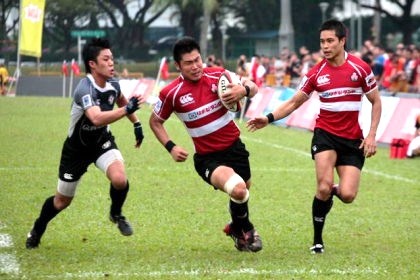
A Japanese player leaves a Singapore player in his wake. (Photo 58 © Ben Goh)

Both teams reaching for a throw-in. (Photo 59 © Ben Goh)

A Japanese player passes the ball just as he gets taken down. (Photo 60 © Ben Goh)











New Zealand with it’s relatively small population have always been a powerhouse.This goes back to their foundation& roots,from primary schools up.Also,the influx of other Pacific Islanders contributed to the success of the sport.
I guess it’s Foundation.What can be done.
Rugbylover brought up a lot of good points.Pathway is the key.
It’s always that transition period,the National Service period that’s the undoing of many potential National Representative.
A lot has been done& still on-going when it comes to the primary/secondary/tertiary level.On any given competition day,you can see the vast amount of participating schools.
One thing I notice is the preferred picking of players to put it bluntly,favourtism displayed by coaches or/and selectors.Not all practise this but it’s a (sad) fact.This so called favouritism happen on pretty much all level& that can be a heavy blow for those affected.
As such,many would flock from club to club or give up the sport entirely.This as I’ve come to learn is part of the problem.
Sad because it is a practise that can bee seen in many sports& not only confined to this island nation.
Perhaps having a ‘A’,’B’ etc team may help.There are many boys who go into National Service but never got the opportunity to continue playing most times because they were posted to units which traditionally do not form the core of,for argument sake, say SAFSA.
Perhaps the union should approach the Units,maybe the MINDEF in a way and convince them to release these boys to play rugby.Afterall,it is still a service to the nation.
This should be done tactfully with a well thought formulated approach.
Just my 2cents.
Well done nonetheless to the boys& to those who are in a ‘dilemma’,do not give up.The harder you fall,the more reason you oughta get up& fight on.
That’s rugby.
Track & Field in SAFSA I understand has been disbanded as well.
rugbylover, the problem you describe I feel is not unique only to rugby. Track and Field also loses many budding athletes from the JC/Poly school system after these student-athletes exit out of their school’s jurisdiction and are left without a ‘parent’ to look after their needs. Those who are left are going it alone, perhaps with a willing coach who gets nothing from his/her sacrifices to coach the athlete.
It just speaks of yet another system that is clearly lacking and I echo your cry to the sports administrators in the NSAs to ‘pull their socks up’ like the athletes who do so in the shadows each and everyday before more dreams and aspirations get waylaid by insufficient support.
With SAFSA disbanding, the worst fears may be realised with the amount of JC/Poly rugby players lost virtually through each yearly intake (could amount to 100s..). Fair enough SAFSA hasn’t been getting the results like the days when the Terrence Khoo and Rong Jing Xiang led teams were most feared and competed fiercely across the land. But at least there’s an outlet, rugby players can continue on their interests and pursue it with the time given off for them to train. Our clubs can only do so much and it really depends on the individual to find time during his 2 years of NS to commit and train for them. This is if the army allows provided he’s not in an active vocation. This leaves the service and support group (those who downgraded due to injuries)of NSFs, who must decide if its worth spending time to train or getting re-injured again. Surely there must be a way to solve this. Les – Has SAFSA disbanded just rugby or has other sports been affected too?
I heard that hockey was disbanded too but I can’t confirm that one.
SAFSA disbanding rugby – I got that info from a SAFSA player.
What a fantastic result!! The boys certainly took it the Japanese in the 2nd half and never gave up till the final whistle. But it also brought out an alarming reality on where Rugby in Singapore can go from here in years to come. Its pretty obvious to see that the sport will continue to be filled with expats dominating the elite squads (10 out of the 15 in the starting XV against Japan to be exact)in the next couple of years if the Union doesn’t work hard to retain their local boys in the senior level. True, the result may spur aspiring local players to train hard and fight for international honours but how do we motivate them when they are done with school and looking a career?
The sport is very bottom heavy with a ton of schools playing from junior level to uni (close to 100)but it thins at the senior elite level (only 4 clubs in the premier league – Bedok, Bucks SCC, Wanderers with 4 in the lower divisions – Blacks, Police, SAFSA and SRC) through the transition from the NS and Uni years. It’s a pity that the likes of schoolboy stars in the late 90s/early 2000s like Steedon Jessup, Chris Tham, Jesal Mandala, Ong Yong Yao, Ravi Shankar, John Pates, Anil Singh, Tobias Ang, Tan Mian Yi, Ho Hua Chyi, etc (the list goes on) would be at their playing prime now (and maybe featuring in last week’s game) but the reality of chasing a good degree and career has proved to be too overwhelming.Out of the names listed, only a handful of their schoolmates are still playing at club level. I kid you not as this will be the same reality for the boys who played in the A Division finals a day before the Japan-Singapore Test match, only a handful of the ACJC/RJC JC 2s will be playing elite rugby in 5-6 years time if this problem is not arrested. The expat eligibility option is not much of a choice as the gap may be too big with not enough locals to choose from with their lack of active participation at the elite club level.
True enough, there’s an academy in place but that’s just a pathway as player to elite level but how about a pathway for their livelihood? Is there career guidance or a job waiting in the ranks should they graduate from school and this rugby academy. Unless we can confidently say that the sport will eventually be semi professional/professional in years down the road. But if not, the drain will continue. Will the Union employ more players (This had been done with the likes of Gary Tan, Tong Chin Hong, Mark Lee, Romi Musa in the past.) to serve different roles in the organisation so that they have the flexibility to train? Or will rugby friendly companies like M1, Mastercard, Guinness and Standchart take the lead by employing these rugby players and placing them on an executive trainee role with the similar arrangements from SRU? I guess this is a problem across the board for all the other NSAs, but i believe Rugby stands out as a sport with its camaraderie and wide networks one can make use of.Suggestions they may be but this could be ways that we can give back to these players who are willing to sacrifice their blood, sweat and tears for the country when reality hits them when they enter the working world. Imagine Japan, a country of 52864 registered senior players who goes to the World Cup without batting an eyelid, beating Singapore a country of just 945 registered senior players by only 30 points (Found in the IRB website). A very proud result indeed but where do we go from here to make sure its not a one off result? How can we continue on to compete with Asia’s best? Only time will tell.
SAFSA has just disbanded their rugby team.
So there is now a significant gap in the playing pathway for boys going through National Service.